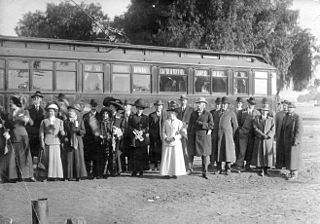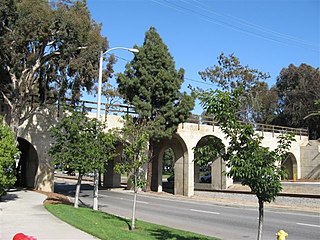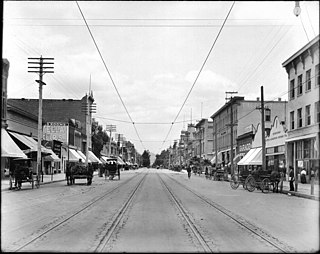
The Pacific Electric Railway Company, nicknamed the Red Cars, was a privately owned mass transit system in Southern California consisting of electrically powered streetcars, interurban cars, and buses and was the largest electric railway system in the world in the 1920s. Organized around the city centers of Los Angeles and San Bernardino, it connected cities in Los Angeles County, Orange County, San Bernardino County and Riverside County.

Glendale–Burbank is a defunct Pacific Electric railway line that was operational from 1904 to 1955 in Southern California, running from Downtown Los Angeles to Burbank via Glendale. Short lines terminated Downtown and in North Glendale, including the popular Edendale Local.

The San Fernando Line was a part of the Pacific Electric Railway system in Los Angeles County, California. It was designed to increase the reach of public transportation from the Downtown Los Angeles and Hollywood into the San Fernando Valley, to support land speculation and development expanding Los Angeles.

The Upland–San Bernardino Line was an interurban line operated by the Pacific Electric Railway between Downtown Los Angeles and San Bernardino, California. This line also had shorter service that terminated before the end of the line at Baldwin Park, Covina, and San Dimas. Though service along this line in its entirety was discontinued in November 1941, it stands as the fourth-longest rapid transit line in American history, after the Sacramento Northern Railway's Chico and Colusa services, and the Pacific Electric's own Riverside–Rialto Line.

Riverside–Rialto was an interurban train service operated by the Pacific Electric Railway from 1914 to 1940, running from Downtown Los Angeles to Downtown Riverside. This was the longest service in the Pacific Electric system, and the only line to have exclusive trackage owned by the Union Pacific instead of the Southern Pacific Railroad. The line reached its highest ridership the year it opened but never recovered at a time when the Inland Empire was far less populated and a commute of that distance was rare.

San Pedro via Gardena was an interurban line of the Pacific Electric Railway. This was the railway's original route to San Pedro. The line was essential in the establishment of light industry in Torrance. The route closely paralleled the present-day Harbor Transitway.

The Sierra Vista Line was a streetcar route mostly operated by the Pacific Electric Railway. It ran from 1895 to 1951 as the short turn making local stops along the Pasadena Short Line on the outside tracks of the Northern Division quadruple-track system.

The Arrowhead Line was a suburban route of the Pacific Electric Railway. It ran from the joint Pacific Electric and Southern Pacific San Bernardino Depot to Arrowhead Springs, by way of D Street.

Riverside Depot is a former train station in Riverside, California.

The San Bernardino–Riverside is a former Pacific Electric (PE) interurban railway line in the Inland Empire. Unlike most of the company's services, trains did not travel to Downtown Los Angeles and instead provided a suburban service between San Bernardino and Riverside.

The Colton Line was a local streetcar line, mostly known as being a service of the Pacific Electric. It operated between Colton and San Bernardino, one of two lines in service between the two cities.

The Riverside–Arlington Line is a former Pacific Electric interurban railway line in the Inland Empire. The route provided suburban service between San Bernardino and Arlington with a later extension to Corona. It operated between 1893 and 1943.

The Upland–Ontario Line is a former Pacific Electric streetcar line in San Bernardino County, California. Cars did not travel to Downtown Los Angeles and instead provided a local service between Ontario and Upland with through service to Pomona.
The Highland Line was a 6.56-mile (10.56 km) local streetcar route of the Pacific Electric Railway. It ran from the San Bernardino Depot to Highland. A short branch line served the Southern California State Asylum for the Insane and Inebriates at Patton.
The Pomona–Claremont Line was a Pacific Electric streetcar line in Southern California. Unlike most of the company's services, cars did not travel to Downtown Los Angeles and instead provided a suburban service between Pomona, Claremont, and Upland.

The Venice Boulevard Line was a local streetcar line of the Pacific Electric. It operated between Downtown Los Angeles and Vineyard Junction, where riders could transfer to interurban cars. Nearly all Venice Short Line cars did not accept local passengers, leaving this as the primary streetcar service along its namesake boulevard.
Streetcars in Redlands transported people across the city and region from 1889 until 1936. The city's network of street railways peaked around 1908 before the patchwork of separate companies was consolidated under the Pacific Electric.
The Pacific Electric Railway established streetcar services in Long Beach in 1902. Unlike other cities where Pacific Electric operated local streetcars, Long Beach's system did not predate the company's services. Long Beach's network of streetcars peaked around 1911 with over 30 miles (48 km) of tracks throughout the city. Local services were discontinued in 1940, but interurban service to Los Angeles persisted until 1961. The route of the former main interurban line was rebuilt in the late 1980s as the Metro Blue Line, which operates at-grade with car traffic for a portion of its length.

San Pedro featured a network of streetcars between 1903 and 1958. The establishment of the Port of Los Angeles in the early 1900s spurred the development of the nearby city, and electric streetcars provided local transit services for workers and later military personnel. Pacific Electric was the primary operator in the city.













